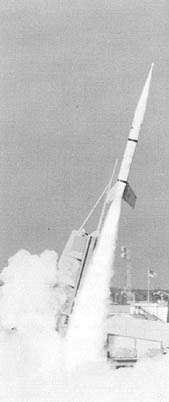Orion (rocket)
Orion is the designation of a small American sounding rocket. The Orion has a length of 5.60 meters, a diameter of 0.35 m, a launch weight of 400 kg, a launch thrust of 7 kN and a ceiling of 85 kilometers. The Orion, built by NASA Goddard Space Flight Center's Wallops Flight Facility, is also used as an upper stage of sounding rockets, usually paired with a Terrier missile as the first stage.[2]
 One of the first Orion rockets (HAWK at the time) shortly after launch. | |
| Function | sounding rocket[1] |
|---|---|
| Manufacturer | NASA |
| Country of origin | United States |
Incidents
A lightning storm over the Wallops launch pad on 9 June 1987 ignited a NASA Orion rocket and 2 other sounding rockets. The Orion flew horizontally about 300 feet into the ocean. The sounding rockets rose to around 15,000 feet altitude, then fell about 2 miles from the launch pad. No persons were hurt in the incident.[3]
References
- International Astronautical Federation; United Nations. Office for Outer Space Affairs; International Institute of Space Law (2007). Highlights in Space 2006: Progress in Space Science, Technology and Applications, International Cooperation and Space Law. United Nations Publications. pp. 58–. ISBN 978-92-1-101147-0.
- Wade, Mark. "Orion Sounding Rocket". Encyclopedia Astronautica. Archived from the original on 2013-11-03. Retrieved 2014-05-08.
- Patricia Tanner, Update, Air & Space/Smithsonian, Vol. 2 No. 3 (August/September 1987), p. 21
This article is issued from Wikipedia. The text is licensed under Creative Commons - Attribution - Sharealike. Additional terms may apply for the media files.
